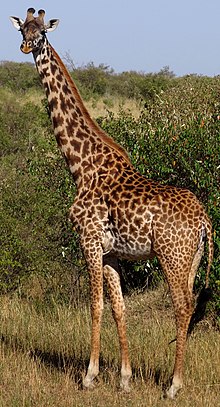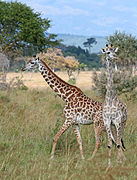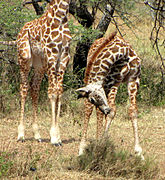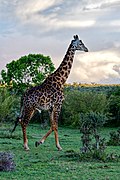
The giraffe is a large African hoofed mammal belonging to the genus Giraffa. It is the tallest living terrestrial animal and the largest ruminant on Earth. Traditionally, giraffes have been thought of as one species, Giraffa camelopardalis, with nine subspecies. Most recently, researchers proposed dividing them into up to eight extant species due to new research into their mitochondrial and nuclear DNA, and individual species can be distinguished by their fur coat patterns. Seven other extinct species of Giraffa are known from the fossil record.

Maasai Mara, also sometimes spelled Masai Mara and locally known simply as The Mara, is a large national game reserve in Narok, Kenya, contiguous with the Serengeti National Park in Tanzania. It is named in honour of the Maasai people, the ancestral inhabitants of the area, who migrated to the area from the Nile Basin. Their description of the area when looked at from afar: "Mara" means "spotted" in the local Maasai language, because of the short bushy trees which dot the landscape.
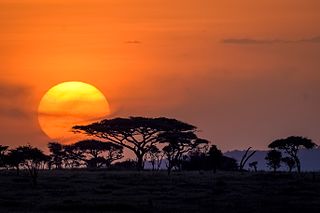
The Serengeti ecosystem is a geographical region in Africa, spanning the Mara and Arusha Regions of Tanzania. The protected area within the region includes approximately 30,000 km2 (12,000 sq mi) of land, including the Serengeti National Park and several game reserves. The Serengeti hosts the world's most massive land animal migration, which helps secure it as one of the Seven Natural Wonders of Africa.

Wildebeest, also called gnu, are antelopes of the genus Connochaetes and native to Eastern and Southern Africa. They belong to the family Bovidae, which includes true antelopes, cattle, goats, sheep, and other even-toed horned ungulates. There are two species of wildebeest: the black wildebeest or white-tailed gnu, and the blue wildebeest or brindled gnu.

The Serengeti National Park is a large national park in northern Tanzania that stretches over 14,763 km2 (5,700 sq mi). It is located in eastern Mara Region and northeastern Simiyu Region and contains over 1,500,000 hectares of virgin savanna. The park was established in 1940.

The Giraffidae are a family of ruminant artiodactyl mammals that share a common ancestor with deer and bovids. This family, once a diverse group spread throughout Eurasia and Africa, presently comprises only two extant genera, the giraffe and the okapi. Both are confined to sub-Saharan Africa: the giraffe to the open savannas, and the okapi to the dense rainforest of the Congo. The two genera look very different on first sight, but share a number of common features, including a long, dark-coloured tongue, lobed canine teeth, and horns covered in skin, called ossicones.

Ngorongoro Conservation Area is a protected area and a UNESCO World Heritage Site located in Ngorongoro District, 180 km (110 mi) west of Arusha City in Arusha Region, within the Crater Highlands geological area of northeastern Tanzania. The area is named after Ngorongoro Crater, a large volcanic caldera within the area. The Ngorongoro Conservation Area Authority administers the conservation area, an arm of the Tanzanian government, and its boundaries follow the boundary of the Ngorongoro District in Arusha Region. The western portion of the park abuts the Serengeti National Park, and the area comprising the two parks and Kenya's Maasai Mara game reserve is home to Great Migration, a massive annual migration of millions of wildebeest, zebras, gazelles, and other animals. The conservation area also contains Olduvai Gorge, one of the most important paleoanthropological sites in the world.

The northern giraffe, also known as three-horned giraffe, is the type species of giraffe, G. camelopardalis, and is native to North Africa, although alternative taxonomic hypotheses have proposed the northern giraffe as a separate species.
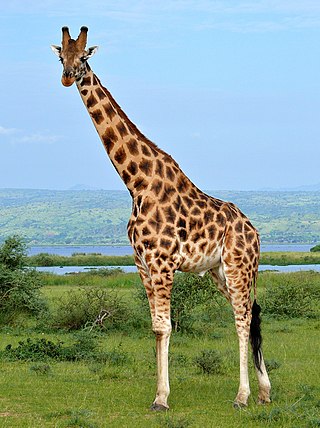
Rothschild's giraffe is a subspecies of the Northern giraffe. It is one of the most endangered distinct populations of giraffe, with 1,399 mature individuals estimated in the wild in 2018.
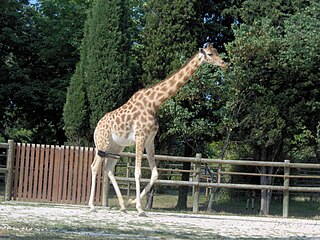
The Kordofan giraffe is a species or subspecies of giraffe found in northern Cameroon, southern Chad, the Central African Republic, and possibly western Sudan. Historically some confusion has existed over the exact range limit of this subspecies compared to the West African giraffe, with populations in e.g. northern Cameroon formerly assigned to the latter. Genetic work has also revealed that all "West African giraffe" in European zoos are in fact Kordofan giraffe. It has been suggested that the Nigerian giraffe's ancestor dispersed from East to North Africa during the Quaternary period and thereafter migrated to its current Sahel distribution in West Africa in response to the development of the Sahara desert. Compared to most other subspecies, the Kordofan giraffe is relatively small at 3.8 to 4.7 meters, with more irregular spots on the inner legs. Its English name is a reference to Kordofan in Sudan. There are around 2,300 individuals living in the wild.
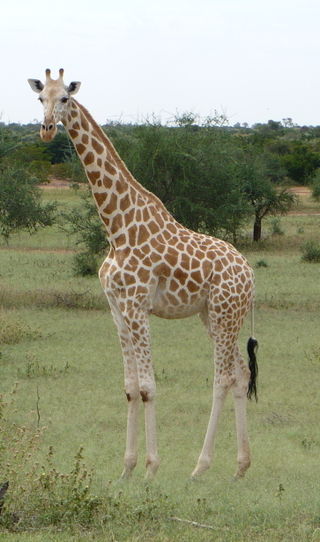
The West African giraffe, also known as the Niger giraffe is a species or subspecies of the giraffe distinguished by its light colored spots. Its last self-sustaining herd is in southwest Niger, supported by a series of refuges in Dosso Region and the tourist center at Kouré, some 80km southeast of Niamey.

The South African giraffe or Cape giraffe is a species or subspecies of giraffe found in South Africa, Namibia, Botswana, Zimbabwe, Eswatini and Mozambique. It has rounded or blotched spots, some with star-like extensions on a light tan background, running down to the hooves.

Thornicroft's giraffe, also known as the Rhodesian giraffe or Luangwa giraffe, is a subspecies of giraffe. It is sometimes considered a species in its own right or a subspecies of the Masai giraffe. It is geographically isolated, occurring only in Zambia’s South Luangwa Valley. An estimated 550 live in the wild, with no captive populations. Its lifespan is 22 years for males and 28 years for females. The ecotype was originally named after Harry Scott Thornicroft, a commissioner in what was then North-Eastern Rhodesia and later Northern Rhodesia.
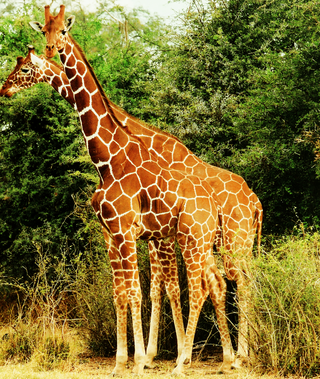
The reticulated giraffe is a species/subspecies of giraffe native to the Horn of Africa. It is differentiated from other types of giraffe by its coat, which consists of large, polygonal, block-like spots, which extend onto the lower legs, tail and face. These prominent liver-red spots also show much less white between them, when compared to other giraffe species. While the reticulated giraffe may yet still be found in parts of its historic range, such as areas of Somalia and Ethiopia, its population stronghold is primarily within Kenya. There are approximately 8,500 individuals living in the wild.
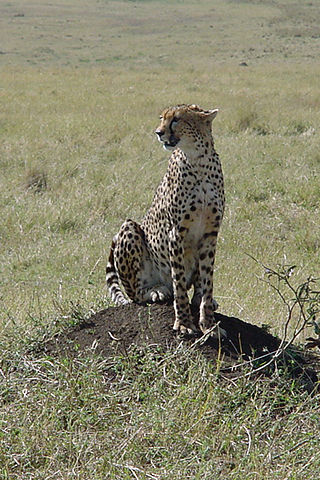
The East African cheetah, is a cheetah population in East Africa. It lives in grasslands and savannas of Tanzania, Kenya, Uganda and Somalia. The cheetah inhabits mainly the Serengeti ecosystem, including Maasai Mara, and the Tsavo landscape.
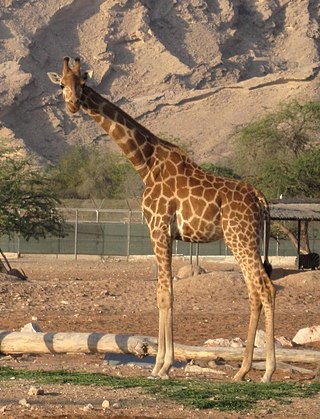
The Nubian giraffe, also known as Baringo giraffe or Ugandan giraffe, is the nominate subspecies or species of giraffe. It is found in Ethiopia, Kenya, Uganda, South Sudan and Sudan. It is currently extinct in the wild of the Democratic Republic of Congo, Egypt and Eritrea. The Nubian giraffe used to be widespread in northeast Africa. The subspecies was listed as Critically Endangered by the IUCN in 2018 for the first time due to a 95% decline in the past three decades.

The Angolan giraffe, also known as the Namibian giraffe or smokey giraffe, is a species or subspecies of giraffe that is found in northern Namibia, south-western Zambia, Botswana, western Zimbabwe and since mid-2023 again in Angola.

The southern giraffe, also known as two-horned giraffe, is a species of giraffe native to Southern Africa. However, the IUCN currently recognizes only one species of giraffe with nine subspecies.
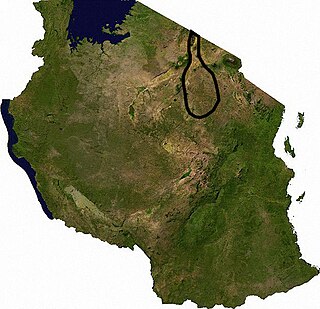
The TarangireEcosystem is a geographical region in northern Tanzania, Africa. It extends between 2.5 and 5.5 degrees south latitudes and between 35.5 and 37 degrees east longitudes.
